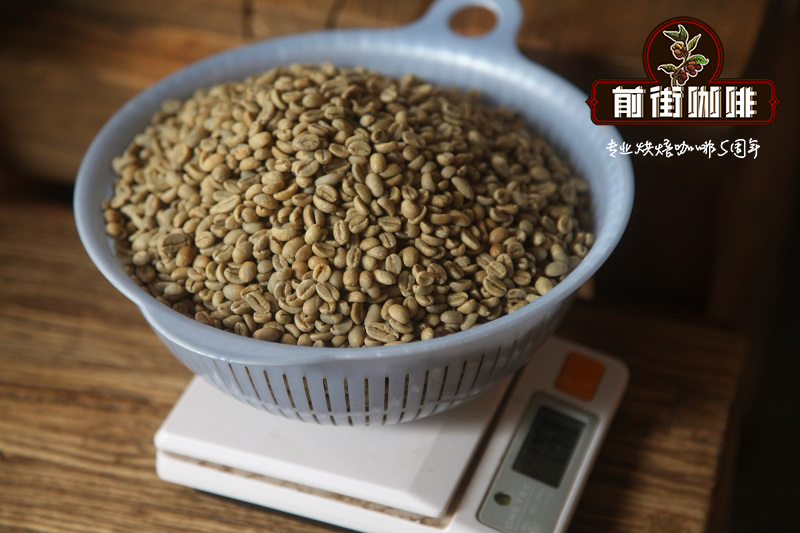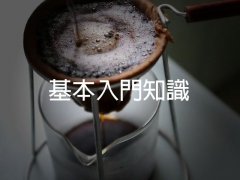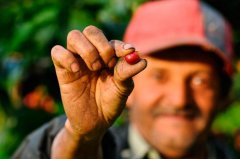Knowledge about coffee raw beans classification and nomenclature of coffee in different countries
G1, G2, G3, G4, AA, PB, SHB, SHG, EP, PLANTATION. What exactly does it stand for?

The messages that may be included in the name of a coffee are:
Country, producing area, variety, treatment method, cup test quality, bean order, bean shape or bean color, defect quantity, raw bean density …... Wait.
In order to really understand the naming of coffee, we must first understand the classification and classification of coffee.
-grading and classification of coffee-
Coffee grading is usually based on defect rate, bean size, altitude, raw bean density, treatment standards, and so on.
Due to historical reasons, trade interests, climate and topography and other factors, each country's producing areas can not be evaluated and classified according to a unified standard or simply on the basis of altitude. Nor can we compare a certain level of one country with that of another country.
The 12 main countries of origin of coffee, different classification and classification standards:
NO.1 Brazil
Brazil Santos NY.2 FC
Country + producing area (port) + graded name + cup test quality
-grading according to defect rate
TYPE type NEW-YORK
(full imperfections)
2 6 defects
2/3 9
3 13
3/4 21
4 30
4/5 45
5 60
5/6
6
-graded according to the size of legumes
Type type Quality quality
NY.2 SC-17/18 FC
NY.2/3 SC-14/16 FC
NY.3/4 DD Quality
NY.4/5 SC-14/16 FC
Through the above classification, we can understand the meaning and rules of the name of Brazilian coffee raw bean:
Brazil Santos NY.2 FC
Country + producing area (port) + graded name + cup test quality
The cup test quality grades in Brazil are as follows:
Fine cup
Fine
Good cup
Fair cup
Poor cup
Bad cup
FC (Fine Cup) and GC (Good Cup) are more common.
Many companies or platforms also add messages such as treatment methods (sun / water washing / honey treatment) and manors.
NO.2 Colombia
-graded according to the size of legumes
Grade Grade
Supamo SC-18 Supremo Sc-18
Supamo SC-17/18 Supremo Sc-17/18
Select the European standard 10% Excelso EP10%
Select high-quality Excelso UGQ
The meaning and rules of the name of Colombian coffee raw bean:
Columbia Huila Supremo SC17/18 FNC
Country + producing area + graded name + other
FNC:Federacion Nacional de Cafeteos de Clolmbia
NO.3 Guatemala
-classified by altitude
Grade Quality altitude Altitude
SHB extremely hard beans Strictly Hard Bean (SHB) 1600 / 1700 metres
Excellent hard bean Fancy Hard Bean 1500 / 1600 metres
Hard bean Hard Bean (HB) 1200 / 1400 metres
Semi-hard bean Semi Hard Bean (SH) 1100 / 1200 metres
Extra high quality water washed bean Extra Prime (EP) 900 / 1100 metres
High quality washed beans Prime Washed 600 / 900metres
Special quality water washed beans Extra Good Washed 700,850metres
Good quality water washed beans Good Washed 700metres
-grading according to defect rate
American standard USP
US preparation
European standard EP
Euro preparation
The best standard GP
Gourmet preparation
Many countries have USP, EP and GP standards, and USP\ EP is relatively more common. European and American standards are based on the specific requirements for the defects or items of raw beans. Generally speaking, the EP standard is higher than the USP standard.
The meaning and rules of the name of raw coffee beans in Guatemala:
Guatemala SHB EP Huehuetenango
Country + altitude level + grading name + producing area
NO.4 Costa Rica
-grading by defect
American standard USP US Preparation
European standard EP European Preparation
-graded by density
SHB extremely hard bean Strictly hard bean from 1200-1650 m
HB hard bean Hard bean from 800m-1100 m
The meaning and rules of the name of Costa Rican coffee raw bean:
Costa Rica Tarrazu SHB EP Red Honey
Country + producing area + graded name + treatment method
NO. 5 Ethiopia
-grading according to defect rate
Grade Grade defect score Defects
1 0-3
2 4-12
3 13-25
4 25-45
5 46-100
6 101-153
The meaning and rules of the name of Ethiopian coffee raw bean:
Ethiopia Yirgacheffee G5
Country + producing area + graded name
UGQ=Usual Good Quality
NO. 6 Kenya
-washing
Level details
PB Doudou Peaberries
AA sieve: 17, 18 mesh = 7.2mm
AB sieve: 15,16 mesh = 6.6mm
C screen: 14, 15 mesh
E elephant bean Elephant
Coffee beans screened out during processing are usually defective and are called "ears". This category also contains some large round beans.
Light beans screened by TT from AA and AB grades
T is less than TT, many fragments. It is a light bean screened by airflow from Class C.
UG unrated: none of the beans meet any of the official criteria
-in the sun
M'buni
MH
ML
The meaning and rules of the classical name of Kenyan raw bean:
Kenya AA FAQ
Country + graded name + cup test quality
10 cup test grades in Kenya:
Fine,Good, Fairto Good, Fairto Average Quality (FAQ), Fair,Poor to Fair, Finally Poor
Among them, FAQ is the most common.
NO.7 Tanzania
-classified by altitude
Level details
AA at least 90% 18 mesh
8-10% 17 mesh at most
Up to 2% 15 mesh
An at least 90% 15bat 6 mesh
Up to 2% 14 mesh
B at least 90% 15bat 6 mesh
C at least 90% 14 mesh
Up to 10% 13 mesh
PB at least 90% 14 mesh
Up to 5% floating beans
AF at least 90% 17 mesh
No more than 8-10% 15 stroke 6 mesh
Up to 2% 14 mesh
TT at least 90% 15x6 mesh
Up to 10% 14 mesh
E at least 90% 18 mesh
At most 10% less than 18 mesh
Nothing less than 15 mesh
-grading according to defect rate
American standard USP
US preparation
European standard EP
Euro preparation
The best standard GP
Gourmet preparation
The meaning and rules of the name of raw coffee beans in Tanzania:
Tanzania AA FAQ
Country + rating name + other
NO.8 Indonesia
-grading according to defect rate
Grade Grade standard
Total defects of G1 Grade 1 are less than 11
G2 Grade 2 total defects are greater than 12 and less than 25
G3 Grade 3 total defects are greater than 26 and less than 44
G4a Grade 4a total defects are greater than 45 and less than 60
G4B Grade 4b total defects are greater than 61 and less than 80
G5 Grade 5 total defects are greater than 81 and less than 150
G6 Grade 6 total defects greater than 151and less than 225th
-the commonly used abbreviations in the export of raw coffee beans in Indonesia are:
Coffee category:
R=Robusta Robusta, A=Arabica Arabica
Handling method:
WP=WetProcessed wet shelling method
DP=DryProcessed dry treatment / solarization
AP= AfterPolished polishing (polishing and removing silver skin)
Manual selection and classification of defective beans:
D _ hand P (second hand selection, Double Picked)
TCMP (three hand selections, Triple pick)
Robusta
Washing Robusta is divided into:
EK1 (Dutch: Eerst Kwaliteit Elementary)
GB (Dutch: Gewone Bereiding minimalist standard)
OIB (Dutch: Oost Indische Bereiding East Indian Standard)
WIB (Dutch: West Indische Bereiding West Indian Standard)
The meaning and rules of the name of raw coffee beans in Indonesia:
Indonesia WIB
Indonesia G1
Country + graded name
WIB is the most common and the highest standard.
NO.9 Vietnam
-graded according to the size of legumes
Grade Grade legume size Screen size
G2 standard, no polishing
G2 standard, unpolished
90% SC13+
G2 standard, polished
G2 standard, polished
90% SC13+
G1 Sc-16 polishing
G1 Sc-16 polished
90% SC16+
G1 Sc-18 polishing
G1 Sc-18 polished
90% SC18+
The meaning and rules of the name of Vietnamese coffee raw bean:
Vietnam G2 Standard Polished
Country + graded name
NO.10 Papua New Guinea
-grading by defect
Grade Grade legume size Screen Size
AA > 18
A 17
AB > 16 (50%)
> 17 (50%)
B > 16
C > 15
PB 11-14s
X mixed
E > 19
PSC > 15mm
Y1 mixed
Y2 mixed
T mixed
(for Arabica only)
The meaning and rules of the name of raw coffee beans in Papua New Guinea:
PNG Plantation Y
Country + planting type + grading name
In Papua New Guinea
Plantation (plantation) and Large Estates (large manor) account for 25% of the country's output.
Small and medium-sized farms (Holdings or Blocks) with a size of 10-20 hectares account for 10% of the yield.
In PNG, there are 76 registered plantations and estates.
NO. 11 El Salvador
-classified by altitude
Central standard Central Standard CS 500900 meters
Highland growth High Grown HG 900-1200 meters
Extremely high altitude growth Strictly High Grown SHG > 1200 meters
-grading according to defect rate
American standard USP
US preparation
European standard EPEuro preparation
The meaning and rules of the name of raw coffee beans in El Salvador:
El Salvator SHG EP
Country + graded name + defect standard
NO. 12 Honduras
-classified by altitude
SHG extremely high altitude growth Strictly High Grown Over 1500 m
HG Highland growth High Grown from 1000 to 1500 m
CS central standard Central Standard Under 1000 m
-grading according to defect rate
American standard USP
US preparation
European standard EPEuro preparation
The meaning and rules of the name of coffee raw bean in Honduras:
Honduras SHG EP
Country + altitude level + defect standard
Important Notice :
前街咖啡 FrontStreet Coffee has moved to new addredd:
FrontStreet Coffee Address: 315,Donghua East Road,GuangZhou
Tel:020 38364473
- Prev

Coffee beans must be learned: the basic basic knowledge of fine coffee
What's the key to a good cup of coffee? Good brewing skills and utensils are indispensable, but high-quality coffee beans are the most important element. Do you have no idea about coffee beans, or are you often dizzy by a bunch of coffee nouns? It doesn't matter. In the following article, we will introduce the important knowledge about coffee beans in the easiest way. Only if there are high quality coffee beans
- Next

What do some English words and numbers stand for on the name of coffee? how can you tell the difference between them?
Professional coffee knowledge exchange more coffee bean information Please follow the coffee workshop (Wechat official account cafe_style) We often see some English words and numbers on the name of coffee. In addition to representing the name of origin, they also have English words like codes or combinations of English plus numbers: for example: Kenya AA Special, Colombia Supremo, Ethiopia Yir
Related
- Beginners will see the "Coffee pull flower" guide!
- What is the difference between ice blog purified milk and ordinary milk coffee?
- Why is the Philippines the largest producer of crops in Liberia?
- For coffee extraction, should the fine powder be retained?
- How does extracted espresso fill pressed powder? How much strength does it take to press the powder?
- How to make jasmine cold extract coffee? Is the jasmine + latte good?
- Will this little toy really make the coffee taste better? How does Lily Drip affect coffee extraction?
- Will the action of slapping the filter cup also affect coffee extraction?
- What's the difference between powder-to-water ratio and powder-to-liquid ratio?
- What is the Ethiopian local species? What does it have to do with Heirloom native species?

